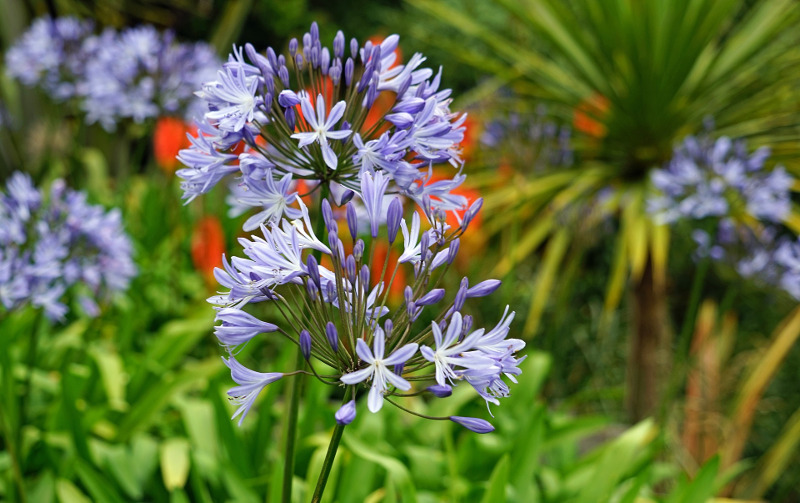Agapanthus Varieties: Picking the Best for Your Landscape
Wiki Article
Understanding the Art of Agapanthus Care: Vital Steps for Healthy Development and Lively Blossoms
In the world of horticulture, the farming of agapanthus stands as a fulfilling venture for those who look for to nurture these stylish flowering plants. With their striking blossoms and stylish foliage, agapanthus has actually captured the focus of garden enthusiasts worldwide. However, accomplishing optimum growth and vivid blooms requires a nuanced approach that encompasses different necessary actions. From picking the ideal variety to understanding pruning strategies, the journey in the direction of cultivating growing agapanthus plants is complex and holds the essential to opening the full capacity of these botanical gems.
Selecting the Right Agapanthus Range

When choosing the ideal Agapanthus range for your garden, think about elements such as environment suitability, flower shade, and growth behavior. In addition, take into consideration the environment in your region to ensure the Agapanthus selection you choose can thrive in your certain conditions. Recognizing the growth behavior of different Agapanthus selections is important for proper placement within your yard.
Ideal Growing Conditions
Considering the optimum ecological needs is vital for effective Agapanthus growing. Agapanthus grows in well-draining soil with a somewhat acidic to neutral pH level. When planting, select a location that gets complete sunlight to partial color. In hotter environments, offering some mid-day color can avoid scorching of the fallen leaves. Agapanthus plants are sensitive to chilly temperature levels and should be safeguarded from frost throughout winter season.To make certain healthy and balanced growth and lively blooms, plant Agapanthus light bulbs at a depth of about 2-4 inches and area them 8-12 inches apart. Mulching around the base of the plants assists preserve moisture and reduces weed development.
Watering and Fertilizing Tips
Preserving correct dampness degrees and giving essential nutrients are essential aspects in the treatment program for Agapanthus plants. When it pertains to watering Agapanthus, it is vital to strike an equilibrium. These plants favor continually moist dirt however are prone to root rot if overwatered. During the expanding season, water deeply when a week, ensuring the dirt is well-draining to prevent waterlogging. In hotter environments or during durations of drought, even more frequent watering might be necessary to keep the soil evenly moist. However, minimize watering in the winter season to stop water logged problems.Feeding Agapanthus is important for advertising healthy development and respected blooms. Use a balanced fertilizer, such as a 10-10-10 formula, in the very early spring as new development arises. Repeat this application every 6-8 weeks throughout the expanding season. Stay clear of too much fertilizing, as it can cause lavish foliage at the cost of flowers. Constantly adhere to the supplier's guidelines for correct dilution and application published here methods. By adhering to these watering and fertilizing ideas, you can guarantee your Agapanthus plants grow and produce vibrant, lasting blooms.
Trimming Techniques for Agapanthus
Pruning Agapanthus plants at the proper times and with correct techniques is vital for keeping their health and promoting ideal development and blooming. The suitable time to prune Agapanthus is in late wintertime or very early spring before new development arises. Beginning by getting rid of any dead or yellowing leaves near the base of the plant. Cut them as close to the ground as feasible without harming the arising shoots.Deadheading invested flowers can also reroute you can try these out the plant's power into creating even more blossoms instead than establishing seeds. If you want to accumulate seeds for propagation, leave some flowers to fully grown and dry on the plant.
Bear in mind to use tidy, sharp devices to make exact cuts and minimize the threat of presenting diseases. Agapanthus. Regular trimming will help keep your Agapanthus looking cool and healthy and balanced while making click here to find out more certain an abundant screen of stunning blooms
Handling Usual Parasites and Conditions
After ensuring correct trimming techniques for Agapanthus, it is vital to address usual insects and conditions that can influence the wellness and vitality of these plants. One common insect that impacts Agapanthus is the Agapanthus gall midget.Another typical issue is fungal fallen leave spot, which provides as dark lesions on the fallen leaves. To avoid fungal conditions, ensure great air blood circulation around the plants, avoid above watering, and remove any infected fallen leaves promptly. Additionally, Agapanthus plants can experience from root rot if they are planted in improperly draining pipes soil. To stop this, plant Agapanthus in well-draining soil and avoid overwatering. By being attentive and taking punctual action against pests and illness, you can assist your Agapanthus plants prosper and create dynamic blooms.

Verdict
To conclude, understanding the art of agapanthus care entails choosing the right selection, offering ideal planting problems, proper watering and feeding, proper pruning methods, and attending to typical bugs and conditions. By adhering to these vital actions, you can guarantee healthy and balanced growth and lively blooms for your agapanthus plants. Bear in mind to consistently keep an eye on and maintain your plants to advertise their general health and long life.To make sure healthy and balanced development and vivid blooms, plant Agapanthus bulbs at a deepness of regarding 2-4 inches and area them 8-12 inches apart. By adhering to these watering and fertilizing tips, you can guarantee your Agapanthus plants flourish and produce dynamic, long-lasting blooms.
One usual insect that influences Agapanthus is the Agapanthus gall midget. Additionally, Agapanthus plants can experience from root rot if they are grown in poorly draining pipes soil. By following these necessary steps, you can make sure healthy development and dynamic blooms for your agapanthus plants.
Report this wiki page